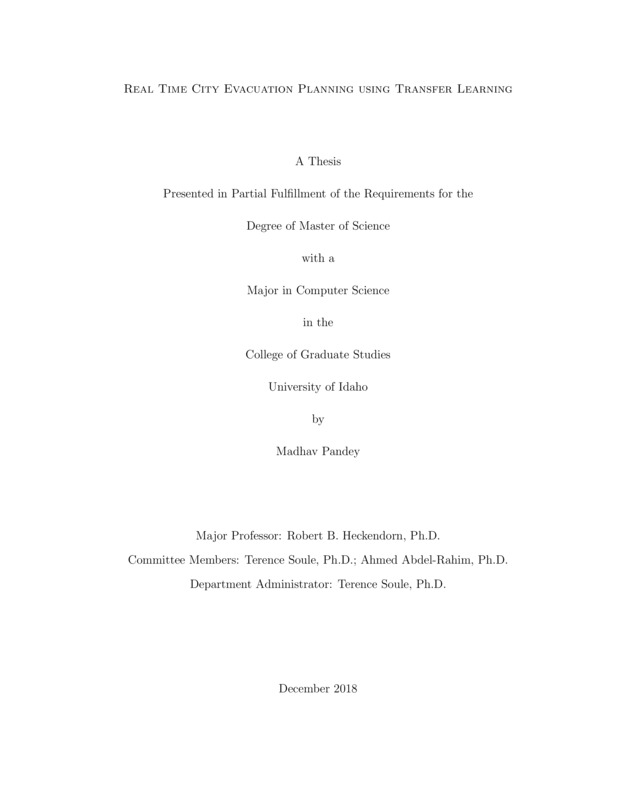Real Time City Evacuation Planning using Transfer Learning
Pandey, Madhav. (2018-12). Real Time City Evacuation Planning using Transfer Learning. Theses and Dissertations Collection, University of Idaho Library Digital Collections. https://www.lib.uidaho.edu/digital/etd/items/pandey_idaho_0089n_11438.html
- Title:
- Real Time City Evacuation Planning using Transfer Learning
- Author:
- Pandey, Madhav
- Date:
- 2018-12
- Program:
- Computer Science
- Subject Category:
- Computer science
- Abstract:
-
The aim of this research is to produce real time city evacuation planning during a disaster which can adapt to changing conditions. Our goal is to save as many lives as possible in the disaster. In this research, we mainly target three things. First, use of population-based evolutionary algorithms to solve city evacuation planning. Second, how past knowledge can be used in the city evacuation for generating adaptive solutions to the changing conditions of a disaster such as bridges collapse, change in safe areas or people not following instructions. This technique of using previous knowledge to solve a different but related problem is called transfer learning. Third, determine the influence of population diversity in transfer learning with evolutionary algorithms.
Evolutionary algorithms are iterative, they start with initial population (set of candidate solutions) and improve those solutions in each iteration. We have used Evolution Strategy (ES) as our evolutionary approach combined with probability based representation. The probability of road being chosen at the intersection is a gene in the problem representation. The list of all the road probabilities in the city form a candidate solution. Each candidate solution in a population gets evolved according to a fitness function which is the total safety value of all people based on where they are located. We perform repeated optimizations based on the current disaster conditions using previous populations as a starting population for reoptimization. We see how diverse solutions can enhance transfer learning.
From all the experiments performed, we found that evolutionary algorithms can solve the city evacuation problem very effectively under the changing conditions of a disaster. When transfer learning is used in evolutionary algorithms, they are helpful to produce better result than just starting with random initial solutions for reoptimization. Also, transfer learning with previous diverse population using Deterministic Crowding (DC) to increase population diversity gave better results than previous population using ES.
- Description:
- masters, M.S., Computer Science -- University of Idaho - College of Graduate Studies, 2018-12
- Major Professor:
- Heckendorn, Robert
- Committee:
- Soule, Terence; Abdel-Rahim, Ahmed
- Defense Date:
- 2018-12
- Identifier:
- Pandey_idaho_0089N_11438
- Type:
- Text
- Format Original:
- Format:
- application/pdf
- Rights:
- In Copyright - Educational Use Permitted. For more information, please contact University of Idaho Library Special Collections and Archives Department at libspec@uidaho.edu.
- Standardized Rights:
- http://rightsstatements.org/vocab/InC-EDU/1.0/

